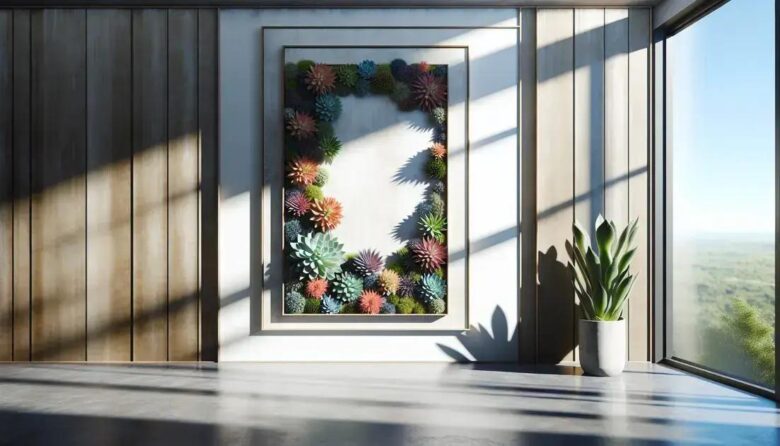Succulent vertical indoor art frames are an innovative decor option, offering low-maintenance beauty by utilizing the drought-tolerant characteristics of succulents, allowing them to thrive with minimal care and adding a natural aesthetic to any indoor space.
Ever thought of having a succulent vertical indoor art frame to spice up your living space? It’s a fantastic way to bring nature indoors while unleashing your creativity. Using succulents for vertical gardening not only transforms your walls but also offers a unique DIY project that anyone can tackle. Ready to explore this exciting decor idea? Let’s dive in!
understanding vertical gardening with succulents
Vertical gardening with succulents is an innovative way to add greenery to indoor spaces where floor space is limited. This method involves growing plants vertically using a structure that can be hung on walls. Succulents are ideal for this type of gardening because they are hardy, drought-tolerant, and require minimal maintenance.
Why Choose Succulents? Succulents are perfect for vertical gardens due to their ability to store water in their leaves, stems, and roots. This makes them low-maintenance and perfect for those who might not have a green thumb. They come in a wide variety of shapes, sizes, and colors, adding visual interest to your indoor decor.
The Basics of Vertical Gardening Start by selecting a frame that can support the weight of your succulents and soil. You can choose from premade frames or create your own from materials like pallets, picture frames, or even shadow boxes. Ensure there’s a backing to hold the soil in place and protect your walls.
While setting up your vertical garden, consider the sunlight needs and positioning. Succulents typically thrive in bright, indirect sunlight. Place your frame in a location that gets adequate light, and rotate it periodically to ensure even growth.
Nutrient and Watering Considerations Given their low water needs, succulents are incredibly efficient in a vertical setting. However, ensure your frame allows for proper drainage to prevent root rot. Over-watering can be a common mistake, so always check that the soil is dry before watering again.
choosing the right succulents for indoor use
Selecting the right succulents for indoor use is crucial to ensure their growth and vibrancy. Succulents vary greatly in preferences when it comes to light, water, and space requirements. Indoors, you’ll want to choose types that can thrive in the lighting conditions of your home.
Lighting Considerations Consider succulents that can thrive in moderate light conditions, like Aloe Vera and Haworthia. These plants are ideal for beginners because they don’t need intense sunlight. However, place them near a window to give them a dose of daily light.
Water Requirements Since succulents store water in their leaves, they require infrequent watering. Choose varieties like Jade Plant or Panda Plant that are particularly drought-tolerant. Ensure that each plant’s soil dries completely before re-watering to prevent root rot.
Space and Growth Some succulents stay compact, making them perfect for limited spaces. For example, Echeveria and String of Pearls are excellent choices for small pots or hanging displays. These small but striking plants can add dimension without overcrowding.
Matching the right succulent to your indoor environment not only enhances their aesthetic appeal but also promotes a lush and healthy indoor garden.
how to construct your own succulent frame
Constructing your own succulent frame can be a rewarding DIY project. Start by selecting a sturdy frame, such as a shadow box or an upcycled picture frame. It should be deep enough to hold soil without spilling over. Add a backing like wire mesh to support your succulents as they grow.
Choosing the Right Materials Begin with a water-resistant backing to protect your walls. You can use a strong plastic sheet or waterproof cloth. Attach a wire mesh inside the frame to hold the soil and plants securely. This mesh allows succulents to root firmly.
Assembling the Frame Fill the frame with a lightweight succulent soil mix. This special soil provides adequate drainage, which is crucial for succulent health. Compact the soil evenly without pressing it down too hard.
Planting and Designing
Arrange your succulents before planting to decide on an aesthetic layout. Start with larger succulents at the bottom and gradually place smaller ones towards the top. This helps in showcasing each plant while ensuring good growth conditions.
After planting, spray the soil lightly with water to help settle the soil and plants. Let the frame lie flat for a few weeks so the succulents can establish their roots. Once settled, you can hang your frame vertically on the wall.
maintenance tips for a healthy indoor display
A healthy indoor succulent display requires consistent care to thrive. Start by ensuring that your succulents receive the right amount of light. Most succulents need bright, indirect sunlight. Rotate your frame every few weeks to promote even growth and prevent the plants from leaning towards the light source.
Watering Techniques Proper watering is crucial for succulents. Use a spray bottle to lightly mist the soil when it becomes dry. Overwatering is a common issue, so ensure the soil has dried out completely between watering sessions. Consider using a moisture meter to gauge soil dampness effectively.
Pest Prevention Keep an eye out for pests such as aphids or mealybugs, which can harm your plants. If you notice an infestation, gently remove pests with a cotton swab dipped in rubbing alcohol. Regularly inspect your succulents to catch any issues early.
Monitor the temperature of your indoor environment. Succulents prefer temperatures between 60°F and 80°F. Avoid placing your display near drafts or in excessively hot areas to prevent stress and potential damage to the plants.
decorating ideas for a stylish indoor art piece
Decorating with a succulent vertical frame can transform any space into a stunning visual art piece. Start by selecting a color scheme. Use succulents with varying shades of green, or mix in some with hints of purple and red to create a vibrant display.
Layering Techniques Arrange your succulents to create depth. Place larger succulents in the foreground and smaller ones towards the back. This adds dimension and draws the eye across the piece. Experiment with different plant heights for a dynamic look.
Creative Backdrops Enhance the aesthetic by pairing the frame with complementary backdrops. A textured wall or a contrasting color can make your succulents pop. Consider lighting installations to highlight your artwork, casting shadows and emphasizing the textures of the plants.
For added elegance, frame your succulent art with wooden or metallic borders. This can help tie in with other decor elements in your room, creating a unified and polished appearance. Personal touches, like small figurines or decorative pebbles, can add interest and showcase your unique style.
addressing common issues with succulent frames
Succulent frames are a unique way to display plants, but they come with their own set of challenges. One common issue is overwatering. To prevent root rot, ensure the frame has adequate drainage and avoid watering until the soil is completely dry.
Pests such as aphids or mealybugs can also affect succulents. Regular inspection of your plants is paramount. To treat infestations, use a gentle solution of soap and water or remove pests manually with a cotton swab and alcohol.
Another issue is insufficient sunlight. Without enough light, succulents can become leggy as they stretch towards the light. Make sure your frame receives bright, indirect sunlight. If natural light is limited, consider using grow lights.
Maintaining the right temperature is crucial. Succulents prefer steady conditions, as sudden temperature changes can cause stress. Keep your display away from vents, drafts, or direct heat sources to maintain optimal plant health.
Creating your perfect succulent art piece
Succulent vertical frames are an innovative way to bring nature indoors while offering a unique decor element that reflects your style. From understanding the basics of vertical gardening to selecting the right succulents, each step adds to the charm of your green display.
Maintaining your frame with proper care and addressing common plant issues ensures that your indoor garden remains healthy and vibrant. Whether for decoration or as a personal project, these frames are versatile art pieces that can enhance any living space.
By applying the tips shared, you can enjoy a thriving succulent display that is both beautiful and low-maintenance. Embark on this green adventure and transform your interiors into lush havens.
FAQ – Frequently Asked Questions About Succulent Vertical Indoor Art Frames
What are the advantages of using succulents for vertical gardens?
Succulents are low-maintenance and drought-resistant, making them ideal for vertical gardens. They store water in their leaves, require minimal care, and come in a variety of colors and shapes.
How do I prevent overwatering my succulent frame?
To avoid overwatering, ensure the soil dries completely between watering sessions. Use a spray bottle for light misting and ensure your frame has proper drainage to prevent excess moisture.
Which succulents are best for indoor use?
Aloe Vera, Haworthia, and Jade Plant are excellent choices for indoor succulent frames due to their adaptability to indoor light and temperature conditions.
How can I control pests on my succulent frame?
Inspect your plants regularly for pests like aphids or mealybugs. Use a solution of soap and water or a cotton swab with alcohol to remove them gently.
How much light do indoor succulent frames need?
Succulent frames thrive in bright, indirect sunlight. If natural light is limited, use grow lights to provide the necessary light for healthy growth.
Can I personalize my succulent frame display?
Yes, you can personalize your display by choosing succulents in different colors and arranging them creatively. Consider adding decorative elements like small figurines or pebbles to enhance the aesthetic appeal.



